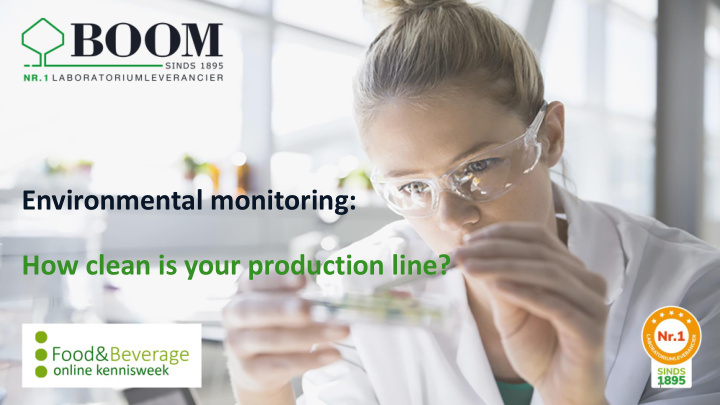



Environmental monitoring: How clean is your production line? 1
• Presenting – Hinke Dekter – Accountmanager (Food and Beverage) • Moderator & QA – Lisette de Vries – Accountmanager and Product specialist 1
1895 - J.A. Boom 1995- B. Boom Products for dairy industry • >90.000 products • Production facility 5000 m 2 warehouse • • Service team 2
Definition of Environmental Monitoring? Sampling and testing the environment and equipment within a food manufacturing facility to prevent cross contamination of the finished product from the environment. 3
Raw Focus of food testing has traditionally been Material Processing environment on raw materials and end product. Now a shift to test in the food processing Food Processing environment (equipment, surfaces, etc.) = Preventive focus identify and correct potential issues before End they lead to a major problem or recall product 4
Hygiene monitoring program 2.0 Visual inspection ATP Traditional bioluminescence/ microbiology Protein test 5
ATP bioluminescence ATP as an indicator of surface cleanliness. The presence of ATP on a surface indicates improper cleaning and the presence of contamination, including food residue, allergens and/or bacteria. 6
• ATP and Protein are well established methods for the determination of hygiene cleanliness BUT cannot be used as a replacement for microbiology • Microbiology determines specific risks (pathogens , spoilers) • ATP allows direct implementation of corrective actions • An effective environmental monitoring program will make use of a combination of technologies (ATP, microbiology, visual testing e.t.c.) 7
Do you know where and when to swab? Zone 1: Product contact Surfaces (Slicers, peelers, fillers, screens, conveyor belts, employee hands, knives work tables e.t.c.) Zone 2: Non food contact surfaces in close proximity to food and food contact surfaces (processing equipment exterior and framework, refrigeration units, equipment control panels, switches e.tc.) Zone 3: More remote non food contact surfaces locates in or near the processing areas (forklifts, wheels, return covers, walls floors drains e.t.c.) Zone 4: Non food contact surfaces outside the processing No ATP areas (locker rooms, cafeterias, maintenance areas e.t.c.) 8
9
Zone 1: Product contact Surfaces (Slicers, peelers, fillers, screens, conveyor belts, employee hands, knives work tables e.t.c.) Zone 2: Non food contact surfaces in close proximity to food and food contact surfaces (processing equipment exterior and framework, refrigeration units, equipment control panels, switches e.tc.) Zone 3: More remote non food contact surfaces locates in or near the processing areas (forklifts, wheels, return covers, walls floors drains e.t.c.) Zone 4: Non food contact surfaces outside the No ATP processing areas (locker rooms, cafeterias, maintenance areas e.t.c.) 10
Indicator or spoilage organisms • Indicator organisms are a key group of organisms that reflect the hygienic status of environmental and processing equipment (not directly related to pathogen presence) and can be used to validate and verify sanitation activities • Spoilage organisms can cause decreased shelf-life, poor product quality, and even product recalls. These outcomes have significant economic and consumer perception consequences. Environmental Management (EM) allows companies to take a proactive approach to controlling spoilage incidents, as they can arise sporadically often go unnoticed. 12
Choosing your device and technique • If the site is a small niche that is difficult to access, a swab may be the best option. • For areas that are larger, a sponge would be best as it allows for more effective collection through higher mechanical action. • On easy-to-clean, flat surfaces in which a higher sensitivity test method is desired (as low counts are expected), direct contact of a medium to the surface may be used. 13
14
…. soooooo There’s no standard procedure because each case is unique, because each production site is different, because each food product is special. 15
Data analysis • Analysis of the data should take place regularly to identify trends and specific issues to allow for appropriate corrections and corrective actions. • Cut-off levels or acceptability limits should be user-defined, based on the risk analysis study done before, as well as historical data. • Presence or levels of indicator organisms above the acceptable limit demonstrate that conditions exist that could lead to loss of process control, potentially resulting in product contamination. 16
Case study • For months now, a hummus producer noticed bloating of the packaging within 1 week (on store shelves) across all of the flavors of hummus they manufactured. • Shelf life was supposed to be 28 days • This company did not have an environmental monitoring program in place. 17
• Sanitation Spoilage organisms test- Hummas natural • Post sanitation Test site CFU/g equipment swabs Coock chickpeas <10 Add mix and ingredients <10 Grinder/blend 3500 Fill container 3200 Seal <10 18
19
….again…. soooo …. Take the time to analyze results in order to gain the full benefit of instituting an environmental monitoring for cleanliness, indicator and spoilage organisms. 20
Boom and microbiology • 3M • BD • Difco • Merck • Oxoid • Tritium • LCG standards 21
Chemicals Equipment 22
Special thanks to… All of you for listing and… 23
Recommend
More recommend